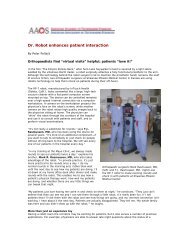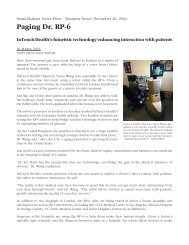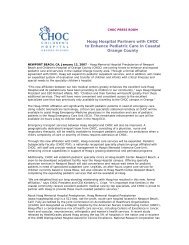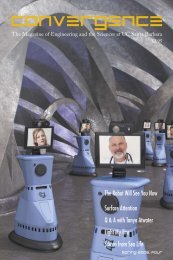UCLA Medical Center Becomes World's First ... - InTouch Health
UCLA Medical Center Becomes World's First ... - InTouch Health
UCLA Medical Center Becomes World's First ... - InTouch Health
Create successful ePaper yourself
Turn your PDF publications into a flip-book with our unique Google optimized e-Paper software.
March 09, 2005 06:30 AM US Pacific Timezone<strong>UCLA</strong> <strong>Medical</strong> <strong>Center</strong> <strong>Becomes</strong> <strong>World's</strong> <strong>First</strong> Hospital to IntroduceRemote Presence Robots in ICU; Clinical Testing for RemoteMonitoring of Intensive Care Unit Patients BeginsLOS ANGELES--March 9, 2005--<strong>UCLA</strong> <strong>Medical</strong> <strong>Center</strong> announced initialclinical tests of the RP-6 mobile robot system in its neurosurgery intensivecare unit (ICU). The RP-6(TM) robot, made by <strong>InTouch</strong> <strong>Health</strong>, Inc. inSanta Barbara, Calif., allows doctors to "virtually" consult with patients,family members, and health care staff at a moment's notice, even if milesaway from the hospital.Dr. Neil Martin beams invia the RP-6 Robot tocheck up on a patientrecovering in <strong>UCLA</strong>'sneurosurgery ICU. Thepatient mimics handmovements as instructedby Dr. Martin as part ofthe clinical assessment.(Photo: Business Wire)Intensivists in the neurosurgery department at <strong>UCLA</strong> are using RP-6 toprovide additional monitoring from their homes and offices of ICU patientsin response to studies showing that intensivist presence in the ICU candecrease morbidity, mortality, length of stay, and cost of care(1). Theproject, to be funded through an assistance agreement with the U.S. Army<strong>Medical</strong> Research and Materiel Command's (USAMRMC), Telemedicineand Advanced Technology Research <strong>Center</strong> (TATRC), located at Ft.Detrick, MD, will be led by Professor and Chief of Neurosurgery, Dr. NeilMartin, Associate Professor Dr. Paul Vespa, and Associate ProfessorValeriy Nenov, Ph.D., all of the David Geffen School of Medicine at <strong>UCLA</strong>.There is a nationwide shortage of intensivists, the physicians whospecialize in the care of critically ill patients. There are less than 6,000practicing intensivists in the United States today and more than 5 millionpatients admitted to ICUs annually(2). Therefore, only about 37 percent ofICU patients receive intensivist care(3), yet having trained intensivists in the ICU results in betteroutcomes and decreased length of stay in the ICU and hospital(1). These specialists are familiar withcomplications that may occur and are therefore better able to minimize errors.<strong>UCLA</strong> will test the RP-6 robot as a way to extend the reach of the intensivist. The patient sees, hearsand interacts with the doctor through the nearly 5.5 foot tall robot, which displays a live video image ofthe physician's face on its monitor/head. The physician, seated at a computer console called aControlStation(TM), also sees and hears the patient through a live video image projected on a monitor.The ControlStation comes equipped with a joystick, which allows the physician to drive the robot to thepatient's bedside, control movements of the robot's head, and even zoom in to take a closer look at thepatient or bedside monitors."The RP-6 robot will increase doctor access for patients, their families, and hospital staff, and <strong>UCLA</strong> isexcited to test the newest addition to our intensive care team," said Martin. "We recognize thatleveraging the health care expert's time offers the possibility of improved patient care, reduced length ofstay, and cost savings. <strong>UCLA</strong> has combined our in-house electronic medical information system, GCQ,with the RP-6 remote presence system and we are able to monitor and access our patients anytimefrom our homes and offices in a way not previously possible." Global Care Quest, or GCQ, founded byMartin, Nenov and Farzad Buxey, is a commercially available, remote wireless mobile patient datasystem developed at <strong>UCLA</strong> <strong>Medical</strong> <strong>Center</strong>.Patient and family reaction to the robot has been very positive. In a study done by Johns HopkinsHospital in Baltimore, Md., half the patients preferred a tele-rounding visit by their own doctor over a'real' visit by another physician. And 80 percent of the patients felt that the robot increased physicianaccessibility(4). Dr. Louis Kavoussi, vice-chairman of urology at Johns Hopkins Hospital said, "Patientslove it! I was very surprised at how much our patients enjoy remote video interactions via the robot."<strong>UCLA</strong> is the first hospital to test the RP-6 robot in the ICU, though more than a dozen other institutionsare using the robot to provide remote medical expertise in areas such as emergency rooms and patientwards.
<strong>UCLA</strong> <strong>Medical</strong> <strong>Center</strong> ranks as one of the best hospital in the Western United States for the 15thconsecutive year according to a U.S. News & World Report survey of 2,550 board-certified physiciansfrom across the country. <strong>UCLA</strong> <strong>Medical</strong> <strong>Center</strong> is a nonprofit, self-supporting 668-bed hospital providingpatient care in all medical specialties. It is the primary teaching hospital for the David Geffen School ofMedicine at <strong>UCLA</strong>. For information about clinical programs or help in choosing a personal physician, call(800) <strong>UCLA</strong>-MD1 or visit http://www.healthcare.ucla.edu/.<strong>InTouch</strong> <strong>Health</strong>(TM) is a privately held company based in Santa Barbara, Calif. <strong>InTouch</strong> <strong>Health</strong> providestechnology solutions which dramatically increase the effectiveness of health care professionals. Thecompany is addressing the impending demographic crisis in acute care by pioneering the use ofRemote Presence(TM) in health care with its RP-6(TM) robotic system. Through a proprietarycommunications and mobile robotic platform, skilled medical professionals are projected to othersettings where a patient or caregiver is located to provide care, coach and train staff, or monitor healthcare services. The <strong>InTouch</strong> <strong>Health</strong> solution leverages the time and expertise of healthcare professionalsacross multiple care facilities, improving the efficiency and effectiveness of care delivery.Global Care Quest is a privately held medical software company based in Torrance, Calif. This state-ofthe-artsoftware solution allows clinicians to view medical data remotely, including patient monitors,imaging systems and medical lab results and reports. Data can be accessed through WiFi and cellularwireless networks on the latest, most popular handheld devices and smart phones. With functions farbeyond pagers and cell phones, GCQ represents the next generation of wireless medicalcommunication and remote patient monitoring. The company has plans to commercialize the technologythrough a license agreement with <strong>UCLA</strong>. More information is available online at:http://www.globalcarequest.com/.NOTE TO EDITORS: Video with interviews and still photos available. A preview of 15 minutes of B-rollfootage is available online at: http://sinapse.arc2.ucla.edu/streaming/healthcare/robotvnr-rm8-300k.ram1. Pronovost PJ, Angus DC,, Dorman T, et al. Physician Staffing patterns and clinical outcomes incritically ill patients: A systematic review. JAMA 2002; 288(17):2151-2162. ASA2. Berenholtz S and Dorman T. Anesthesiologist-Intensivists: improving quality of care and safety in theintensive care unit. ASA Newsletter. Feb 2004, vol. 68, no. 2.3. Angus, DC, Kelley, MA, Schmitz, RJ, et al Current and projected workforce requirements for care ofthe critically ill and patients with pulmonary disease: can we meet the requirements of an agingpopulation? JAMA 2000;284,2762-27704. Ellison L, Pinto P, Kim F, et al. Telerounding and patient satisfaction after surgery. J Am Coll Surg2004: 199:523-530







